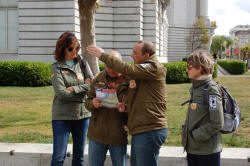Modification: the essentials

One dictionary definition of modify is:
to change something ... usually to
improve it or make it more acceptable
Cambridge International Dictionary of
English, 1995, Cambridge: Cambridge University Press
That's almost good enough for our purposes but in the analysis of language, the term is used in a slightly more technical sense. Modification involves altering or adding to the meaning of an element of the language to make it fuller, more acceptable or more accurate. It is an alteration to form which results in an alteration to the meaning of what we say.
This is an essential guide. For more detail, use
the in-service guides, linked from
the syntax
index.
There is also
an overview of modification which you can access here.
 |
The two main categories of modification |
Here's an example of an unmodified sentence in English:
A man went
While we understand the meaning of that, it tells us very little about any of the elements of the clause. We don't know which man, or where, when or how he went. We do know that the going happened before now and that the person who went is a single, male adult and that's about it. In fact, the noun is modified by the indefinite article, a, but that is a quirk of English grammar which does not tell us much more about the man except that he is not (probably) known to the hearer.
Here's the same sentence in which the elements are modified to provide the information a
hearer needs to make much sense of it:
That young
man
in a red jacket
quickly went
to the window when he heard the crash
That young man
in a red jacket
quickly went
to the window
when he heard the crash
The sentence is repeated here to show the two fundamental kinds
of modification.
In the first, the modifiers are highlighted in
red and in the
second the modifiers are highlighted in
black.
The two main categories of modification are:
- Pre-modification:
- The word that, a demonstrative determiner in the jargon, tells us which man and also indicates that he is not near us now. If we say this young man, we would imply that he is here with us.
- The word young, a gradable adjective, tells us something more about the man.
- The word red, an ungradable adjective, provides the identifying characteristic of the jacket.
- The words a and the are articles, a
kind of determiner:
- The first, a, is an indefinite article and tells us that the jacket is not known to the hearer. If we say in the red jacket, that would imply that the jacket has been seen before by both the speaker and the hearer.
- The second, the, is the definite article and implies strongly that the fact of the crash is already known to the hearer and the speaker knows this. It is not new information. It also occurs in the window and suggests that there was only one window in question (or, indeed, that there was only one window in the room).
- The word quickly, a gradable adverb, tells us the manner of the man's going. It could come after the verb, went quickly, and would then fall into the next category although the meaning would not change.
- Post-modification:
- The words in a red jacket, a prepositional phrase, allow us further to identify the man.
- The words to the window, another prepositional phrase tell us the direction and destination of the going.
- The words when he heard the crash form a
subordinate clause and tell us two things:
- when the man went to the window and
- why he went to the window (probably)
There are still some elements of the sentence that remain unmodified or which could be further modified. For example:
- We could add an adjective to the noun
crash and have:
a terrible / loud / sudden crash
etc. - We could post-modify the noun, crash,
too, and have:
a crash in the street / outside the house
etc. - We could pre-modify and post-modify the
noun window and have:
the open window by the door / the corner window near the bookcase
etc. - We can add prepositional phrases,
adverbs and adjectives almost infinitely to the other elements,
too and have:
the red leather jacket with brass buttons
quickly and determinedly went across the crowded living room
etc.
In theory at least that is no limit to the amount of modification we can use to elaborate the sentence. In practice, naturally, modification is limited to the amount the hearer or reader can readily understand and the important information we want to convey.
 |
What do we modify and how do we do it? |
In order for you to understand what follows, we need to do a little phrase analysis.
A phrase in language analysis refers to an element of a clause or sentence which performs a recognisable grammatical function. Here is how:
| The sentence: | My | father | carefully | drove | the | recently | repaired | car | into | the | garage |
| The word classes: | possessive determiner | noun | adverb | verb | definite article | adverb | adjective | noun | preposition | definite article | noun |
| The phrases: | noun phrase | verb phrase | noun phrase | prepositional phrase | |||||||
To explain:
- The top row contains the sentence, broken down into the eleven words that make it up
- The second row identifies the classes of the eleven words
- The third row groups the words into the 4 main phrases that make up the sentence. We could include a fifth phrase, the adjectival phrase recently repaired but it is embedded in the second noun phrase.
Even in a sentence with no modification such as:
Birds have wings
we still have a noun phrase (birds), a verb phrase (have)
and another noun phrase (wings).
For the purposes of analysing modification, it is not necessary to
distinguish between a constituent of the sentence made up of a
single word or one made up of multiple words. They are phrases
in both cases.
So, for example, when we say that the noun phrase father is
pre-modified by the possessive determiner my to become the
noun phrase my father, we are simply stating something true
about the phenomenon, not making a distinction between a word and a
phrase.
In our example, the following are the grammatical functions of each phrase:
- My father: the subject noun phrase
- carefully drove: the transitive (i.e., taking an object) verb phrase
- recently repaired: an adjective phrase which is part of the next noun phrase
- the recently repaired car: the object noun phrase which includes the adjective phrase
- into the garage: the prepositional phrase post-modifying the verb phrase (it is, in the jargon, an adverbial, not an adverb)
The following concerns, in outline only, how we can modify each of these main constituents of a sentence.
 |
Modifying noun phrases |
| the old man in the hat with the fishing rod |
When we modify noun phrases, we are usually concerned with identifying which (or what) and where the noun is. Here are some examples of both:
- determiners:
that man
the man
some men
one man
etc. - adjectives and adjective phrases:
old man
tired man
very old man
etc. - prepositional phrases:
the man with the fishing rod
the man in the silly hat
an old man on his own
the man in the boat
the house on the corner
etc.
These are simple examples but it is possible to get more complicated (at least, it looks that way) although the type of modification is, in principle, the same. For example:
- The six men
with two determiners giving different information to identify men - The extremely tired and deeply unhappy people
with a complex adjective phrase modifying the noun - The man in the corner in the red coat with the dog
with three prepositional phrases telling us where, wearing what and with what
In English, determiners and most adjectives come before the noun
(i.e., they are pre-modifiers, in English) and prepositional phrases follow the
noun (i.e., they are post-modifiers).
Other languages do things differently.
 |
Modifying verb phrases |
| quietly thinking carefully about a move |
Anything that modifies a verb or verb phrase is, by definition
an adverbial. Some are adverbs, all are adverbials.
When we modify verb phrases to make more complex phrases, we are
usually concerned with one of the following:
- Where the state or event takes place:
Playing chess in the park (a prepositional phrase post-modifier)
Waiting outside (an adverb post-modifier) - How the event happens:
Thinking deeply (an adverb post-modifier)
Playing with great skill (a prepositional phrase post-modifier)
Mistakenly moving (an adverb pre-modifier) - When the action occurs
Playing yesterday (an adverb post-modifier)
Frequently losing (a frequency adverb pre-modifier)
Winning at the moment (a prepositional phrase post-modifier) - The extent of the action:
Playing for hours (a prepositional phrase post-modifier)
Continually playing (an adverb pre-modifier)
That is not the end of the possible ways of pre- and post-modifying verb phrases but this is an essential guide. For more, consult the in-service guides to the area.
 |
Modifying adjectives to make adjective phrases |
| an extremely ancient site |
The usual way to modify an adjective is by inserting a pre-modifying adverb. These can amplify the meaning of the adjective, make it less strong or emphasise it. For example:
- It is extremely ancient (an amplifier)
- It is fairly old (a downtoner)
- It is obviously old (an emphasiser)
We can also use some prepositional phrase post-modifiers to achieve a similar effect. For example:
- It is ancient in some areas (diminishing the adjective)
- It is old by all accounts (limiting the adjective)
- It is old in general (making the adjective approximate)
 |
Modifying adverbs to make adverb phases |
| he explained extremely clearly |
Just as we can amplify the strength of an adjective, we can do the same to an adverb but in this case only amplification or emphasis is possible. For example:
- They arrived surprisingly late
- It is very well made
- She danced fantastically enthusiastically
 |
Modifying prepositional phrases |
Prepositional phrases can be modified with adverbial
phrases. The modification always precedes the phrase.
Prepositional phrases of time and place are most commonly (i.e.,
not solely) the ones we can modify.
The modifiers are adverbials and serve to amplify or tone down the
phrase.
For example:
- His explanation went completely over my head.
- They were very nearly on time.
- The bullet went clean through the window.
- It's almost directly opposite the station.
- The meeting started shortly after 6 o'clock.
- The man spoke purely in his own interests.
- That's a comment very much out of order here.
- We looked all over the town for a replacement.
- My house is right behind the school.
- Wholly in my opinion, this is the wrong way to proceed.
For more, see the guide to prepositional phrases linked from the index below.
| For more, try | the in-service syntax index |
